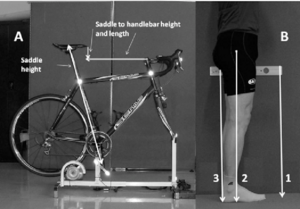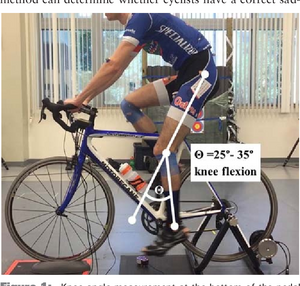Knee Injury Prevention In Cyclist
Introduction:[edit | edit source]
Bicycle riding is a popular form of sport, recreation, fitness and transportation in many areas of the world. The health benefits of participating in regular physical activity are well established, so now a days recreational cycling activity has been very popular and therefore not surprising that patients presenting with injuries related to cycling may also increase. But many common cycling injuries of the lower extremity are preventable.
Studies suggests that cycling is a healthy recreational activity, although it can result in acute and chronic or overuse injuries. Acute injuries may occur due to road traffic accidents which can be prevented by using helmet and following proper traffic rules. But chronic injuries require specific ergonomics and proper physiotherapy guidelines for various factors responsible for injury.
The most common anatomical sites for overuse injury/complaints reported by studies were the back, knees, neck and shoulder, groin and buttocks, and hands.
Anatomy of Cycle[edit | edit source]
Risk factors for overuse injury:[edit | edit source]
Incorrect bicycle configuration may predispose athletes to injury and reduce their cycling performance.
The patellofemoral joint is under particular stress in bicycling thus Patellofemoral pain (PFP) is a common overuse injury in cycling. Risk factors for PFP can be divided into extrinsic and intrinsic factors. Extrinsic factors for PFP are incorrect saddle height or position, incorrect cleat alignment and incorrect cadence. While intrinsic factors for PFP are poor strength of core, pelvic and lower limb muscles and poor flexibility of flexors and extensors of lower kinetic chain.
Ergonomics on cycling setting:[edit | edit source]
According to studies following settings should be done to prevent overuse injury for Knee joint in cyclist:
- Mid saddle height based on Trochanteric Length Method (100%) or Holmes et al. Method with knee flexion 25 to 30 degrees.
- Anterior foot position is defined as the contact with the head of the second metatarsal (ball of foot) and the pedal surface.
- Keeping the saddle and hand bars at the same height.
Measurement of saddle height[edit | edit source]
Position of saddle is very important to find the effect of it on cycling performance and knee injury risk for athlete. A variety of methods have been proposed, some of which are based upon scientific studies and others on anecdotal experience. Some of the scientific methods are discussed below:
| No. | Method | measurement of subject | measurement on cycle | percentage of setting |
|---|---|---|---|---|
| 1. | Hamley and Thomas Method (see fig. 1) | Subject in standing, inseam leg
length measurement. |
saddle to pedal distance | 109% |
| 2. | Trochanteric Length Method (see fig. 1) | Subject in standing, the length from the most prominent bony surface of the greater trochanter to the floor. | saddle to the center of the bottom bracket distance | 100% |
| 3. | Length from ischial tuberosity to floor (see fig. 1) | Subject in standing, length from ischial tuberosity to floor | saddle to the center of the bottom bracket distance | 113% |
| 4. | Holmes et al. Method | Measurement of the knee angle flexed
when the pedal is at the bottom dead center and the cyclist is seated on the saddle |
- |
Ergonomics on cycling setting:
- Mid saddle height based on Trochanteric Length Method (100%) or Holmes et al. Method with knee flexion 25 to 30 degrees.
• The saddle height will be measured as the greatest distance from saddle surface to the center of the pedal surface in a straight line along saddle pillar (tube) and crank.
- Anterior foot position is defined as the contact with the head of the second metatarsal (ball of foot) and the pedal surface.
- Keeping the saddle and hand bars at the same height.








